淄博英文介绍.ppt
- 格式:ppt
- 大小:4.89 MB
- 文档页数:15
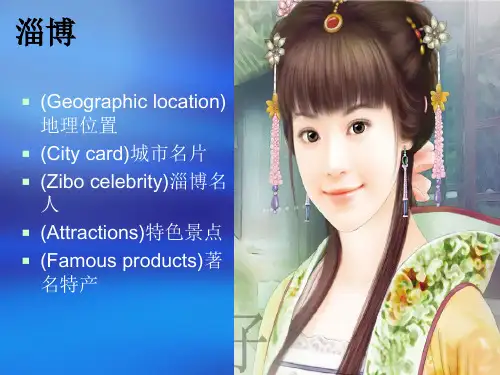
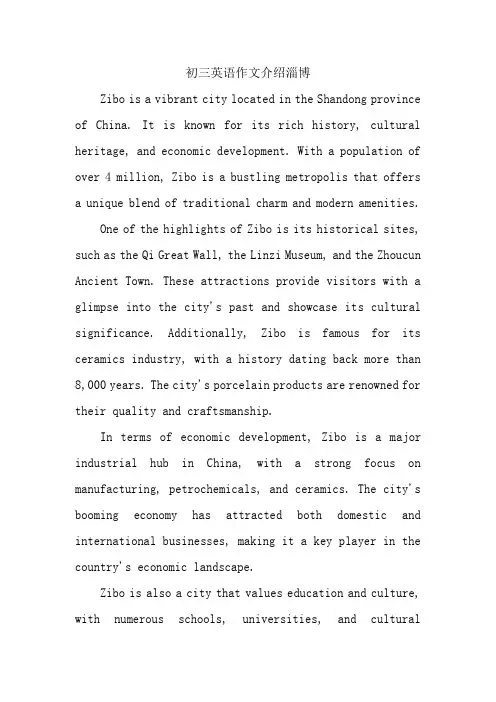
初三英语作文介绍淄博Zibo is a vibrant city located in the Shandong province of China. It is known for its rich history, cultural heritage, and economic development. With a population of over 4 million, Zibo is a bustling metropolis that offers a unique blend of traditional charm and modern amenities.One of the highlights of Zibo is its historical sites, such as the Qi Great Wall, the Linzi Museum, and the Zhoucun Ancient Town. These attractions provide visitors with a glimpse into the city's past and showcase its cultural significance. Additionally, Zibo is famous for its ceramics industry, with a history dating back more than 8,000 years. The city's porcelain products are renowned for their quality and craftsmanship.In terms of economic development, Zibo is a major industrial hub in China, with a strong focus on manufacturing, petrochemicals, and ceramics. The city's booming economy has attracted both domestic and international businesses, making it a key player in the country's economic landscape.Zibo is also a city that values education and culture, with numerous schools, universities, and culturalinstitutions scattered throughout the city. The city's vibrant arts scene, bustling markets, and delicious local cuisine further contribute to its appeal.Overall, Zibo is a city that seamlessly blends tradition with modernity, offering visitors a unique and enriching experience that highlights the best of Chinese culture and heritage.中文翻译:淄博是中国山东省一个充满活力的城市。
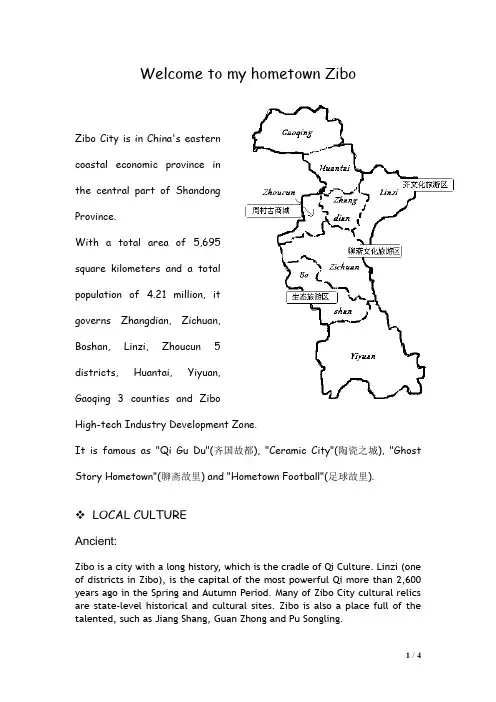
Welcome to my hometown ZiboZibo City is in China's easterncoastal economic province inthe central part of ShandongProvince.With a total area of 5,695square kilometers and a totalpopulation of 4.21 million, itgoverns Zhangdian, Zichuan,Boshan, Linzi, Zhoucun 5districts, Huantai, Yiyuan,Gaoqing 3 counties and ZiboHigh-tech Industry Development Zone.It is famous as "Qi Gu Du"(齐国故都), "Ceramic City"(陶瓷之城), "Ghost Story Hometown"(聊斋故里) and "Hometown Football"(足球故里).LOCAL CULTUREAncient:Zibo is a city with a long history, which is the cradle of Qi Culture. Linzi (one of districts in Zibo), is the capital of the most powerful Qi more than 2,600 years ago in the Spring and Autumn Period. Many of Zibo City cultural relics are state-level historical and cultural sites. Zibo is also a place full of the talented, such as Jiang Shang, Guan Zhong and Pu Songling.Modern:Zibo is a city with rapid development in every area, including agriculture, finance, insurance, real estate, tourism, information services and so on. Especially, its tertiary industry is among the ranks of China Excellent T ourism City in 2001. As an important industrial base and cultural center, Zibo will play its important and new role in economy development and cultural transmission.POINTS OF INTERESTS1. The Ancient Qi City Relics Museum✓@ Linzi district, which is famous for the birthplace of world football and a national city of history and culture.✓The Qi state is one of the countries of the Zhou Emperor (around 1100BC - 256BC). ✓The ancient Qi city is among the first batch of cultural relics protection units authorized by the State Council. With 48 important historical sites inside, it has won the title of "Underground Museum".✓The Qi History Museum shows an architecture feature of ancient castle fashion, and is one of the Ten Big Peculiar Museums of China. 308 sets or pieces of delicate cultural relics displayed in the 15 exhibition halls show a panorama of the glorious history and culture of Qi state that lasted 800 years. Moreover, the Qi History Museum has won the Top Ten Elite Displaying Nomination Prize.2.The Former Residence of Pu Songling✓@ Pujiazhuang village of Zichuan district, which is the hometown of Pu Songling.✓Pu Songling is a famous Chinese writer of the 17th century, reputed as "King of Short Stories in the world". His book Strange Tales from Make-do Studio enjoys great popularity.✓The old residence of Pu Songling consists of a main room and two chambers, elegant and unusual. The main room has old furniture used by Pu Songling. The chambers are now the exhibition halls for Pu Songling's life.✓The make-do studio is the center of the Former Residence. It was the place where Pu Songling was born, read and wrote as well. On the middle of the wall opposite the door is hung a horizontal tablet inscribed with two Chinese characters, 聊斋(liaozhai). ✓Willow Spring, also called "Full Well", was the place where Pu Songling collected materials for writing in those days. The well was always full of water, hence the name.Legend has it that this teahouse was set up by Pu Songling. He offered free tea to all the people passing by, only asking everyone to tell him a story. On the basis of the stories, Pu wrote his masterpiece Strange Tales from Make-do Studio. By the way, Pu Songling was so fond of this place that he called himself "willow spring hermit".3. Zibo China Ceramic Museum✓@ Zhangdian district, the center of Zibo. It is one of the five major ceramics production areas in China. Zibo has a long history of producing ceramics, which ranks an important position in China.✓Zibo Ceramics Museum is lying at the center of Zibo Culture Square. It is a comprehensive modern museum with the function of display, exhibition, collection, research, marketing and social education.✓The display area of Zibo Ceramics Museum is 4000 square meters. It is a modern ceramics museum with the biggest display area, the most complete varieties. It displays 2500 pieces or sets of all kinds of excellent porcelain work from 8000 years ago to now. The exhibition hall is divided into seven areas. When you visit Zibo Ceramics Museum, you can know well of the splendid culture of 8000 years history of Zibo ceramics and the newest development merits.4.Other places of interestBoshan Kaiyuan Cave (in Boshan);Zhoucun street (in Zhoucun);Lushan County Forest Park (in Yiyuan), etc.LOCAL SPECIALITIES✧Zhoucun shaobingA famous specialty of Shandong province;It is produced in the Zibo Zhoucun. It has gone through a very long history. In Han Dynasty (206B.C.-A.D.220), it was called "Hu Bing".Four characteristics: crisp, fragrant, thin and brittle. If you lose one piece, it will fall into pieces.✧Boshan crisp panA traditional, seasonal dish.Especially popular in the winter and during the Spring Festival.It is said that it was produced by a woman named Su Hsiao in Qing dynasty, so people name the dish "Su pot". "Su" means both the surname Su and the characteristic "crisp"(in Chinese, ”crisp” can be translated into “酥”).The main ingredients: vinegar, the meat of fish, Chinese cabbage, kelp, lotus root and so on.✧CeramicsLuxurious, elegant, smooth and delicate.Boshan art ceramics, especially the traditional "rain dropglaze" and "tea-dust glaze" are still regarded as the international market treasures.OUR WEEKEND SCHEDULE:Morning Lunch Afternoon Friday Arrive at ZhangdianSaturday The Former Residenceof Pu Songling(Zichuan, by bus)Local specialties(Boshan crisp pan,ceramics ),Kaiyuan CaveZhoucun street,Zhoucun shaobingSundayThe ancient Qi cityrelics museum (Linzi)Back to Zhangdian(to eat lunch and havea short rest)Zibo China CeramicMuseum(Zhangdian)During the whole tour, you have enough time to buy souvenirs and food and take photos.HAVE A GOOD TIME!。
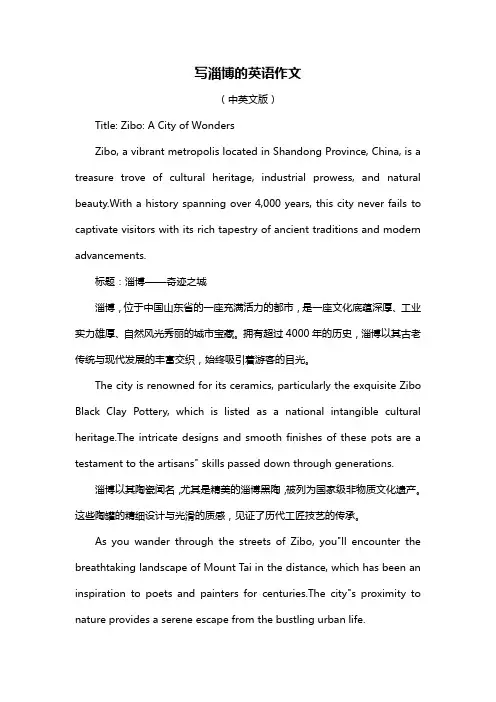
写淄博的英语作文(中英文版)Title: Zibo: A City of WondersZibo, a vibrant metropolis located in Shandong Province, China, is a treasure trove of cultural heritage, industrial prowess, and natural beauty.With a history spanning over 4,000 years, this city never fails to captivate visitors with its rich tapestry of ancient traditions and modern advancements.标题:淄博——奇迹之城淄博,位于中国山东省的一座充满活力的都市,是一座文化底蕴深厚、工业实力雄厚、自然风光秀丽的城市宝藏。
拥有超过4000年的历史,淄博以其古老传统与现代发展的丰富交织,始终吸引着游客的目光。
The city is renowned for its ceramics, particularly the exquisite Zibo Black Clay Pottery, which is listed as a national intangible cultural heritage.The intricate designs and smooth finishes of these pots are a testament to the artisans" skills passed down through generations.淄博以其陶瓷闻名,尤其是精美的淄博黑陶,被列为国家级非物质文化遗产。
这些陶罐的精细设计与光滑的质感,见证了历代工匠技艺的传承。
As you wander through the streets of Zibo, you"ll encounter the breathtaking landscape of Mount Tai in the distance, which has been an inspiration to poets and painters for centuries.The city"s proximity to nature provides a serene escape from the bustling urban life.当你漫步在淄博的街头巷尾,远眺壮丽的泰山风景,便会感受到几个世纪以来诗人画家们从中汲取的灵感。
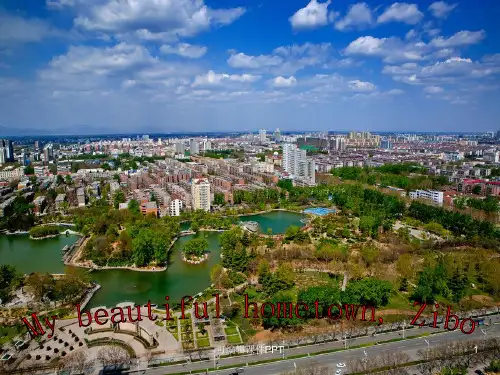
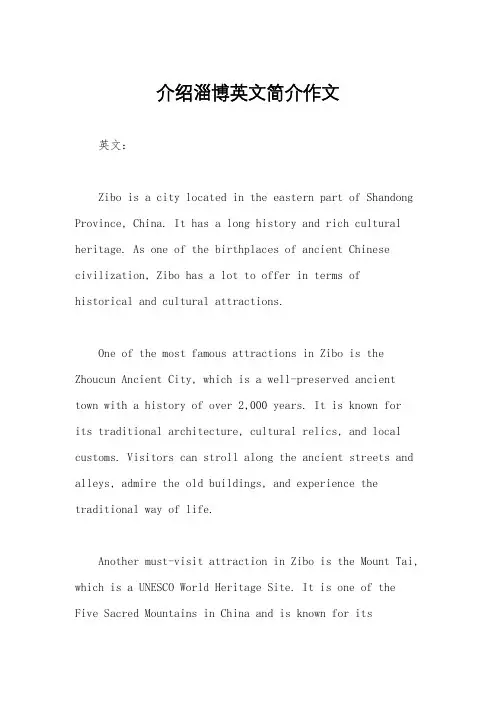
介绍淄博英文简介作文英文:Zibo is a city located in the eastern part of Shandong Province, China. It has a long history and rich cultural heritage. As one of the birthplaces of ancient Chinese civilization, Zibo has a lot to offer in terms ofhistorical and cultural attractions.One of the most famous attractions in Zibo is the Zhoucun Ancient City, which is a well-preserved ancient town with a history of over 2,000 years. It is known forits traditional architecture, cultural relics, and local customs. Visitors can stroll along the ancient streets and alleys, admire the old buildings, and experience the traditional way of life.Another must-visit attraction in Zibo is the Mount Tai, which is a UNESCO World Heritage Site. It is one of the Five Sacred Mountains in China and is known for itsstunning natural scenery and cultural significance.Visitors can hike to the top of the mountain, visit the temples and shrines, and enjoy the panoramic views of the surrounding landscape.Apart from the historical and cultural attractions,Zibo is also a modern and vibrant city with a thriving economy. It is home to many industries, such as ceramics, glass, and petrochemicals. The city has a well-developed transportation system, including airports, highways, and railways, making it easy for visitors to travel to and from Zibo.Overall, Zibo is a city that offers a unique blend of ancient history and modern development. It is a great destination for those who want to explore the rich cultural heritage of China while experiencing the dynamic andvibrant atmosphere of a modern city.中文:淄博位于中国山东省东部,有着悠久的历史和丰富的文化遗产。
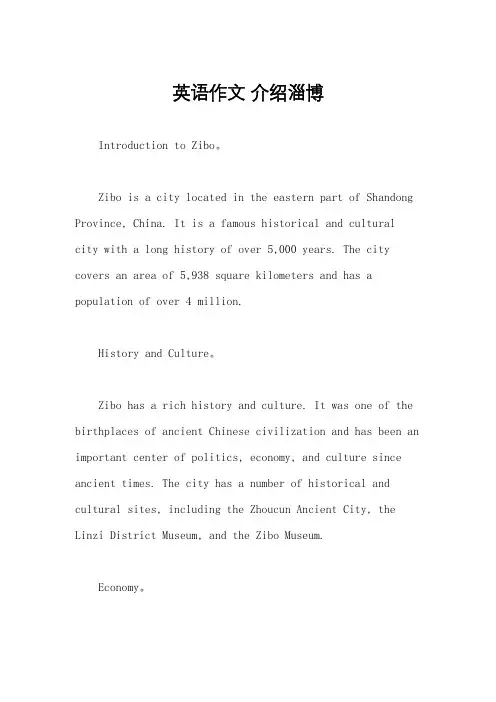
英语作文介绍淄博Introduction to Zibo。
Zibo is a city located in the eastern part of Shandong Province, China. It is a famous historical and culturalcity with a long history of over 5,000 years. The city covers an area of 5,938 square kilometers and has a population of over 4 million.History and Culture。
Zibo has a rich history and culture. It was one of the birthplaces of ancient Chinese civilization and has been an important center of politics, economy, and culture since ancient times. The city has a number of historical and cultural sites, including the Zhoucun Ancient City, the Linzi District Museum, and the Zibo Museum.Economy。
Zibo is an important economic center in Shandong Province. It has a well-developed economy and is known for its ceramics, petrochemicals, and metallurgy industries. The city is also home to a number of large companies, including Shandong Weiqiao Pioneering Group Co., Ltd., one of the world's largest cotton textile producers.Tourism。
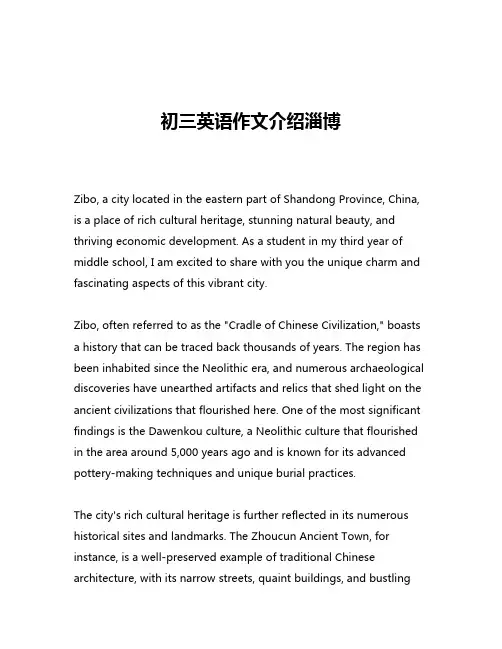
初三英语作文介绍淄博Zibo, a city located in the eastern part of Shandong Province, China, is a place of rich cultural heritage, stunning natural beauty, and thriving economic development. As a student in my third year of middle school, I am excited to share with you the unique charm and fascinating aspects of this vibrant city.Zibo, often referred to as the "Cradle of Chinese Civilization," boasts a history that can be traced back thousands of years. The region has been inhabited since the Neolithic era, and numerous archaeological discoveries have unearthed artifacts and relics that shed light on the ancient civilizations that flourished here. One of the most significant findings is the Dawenkou culture, a Neolithic culture that flourished in the area around 5,000 years ago and is known for its advanced pottery-making techniques and unique burial practices.The city's rich cultural heritage is further reflected in its numerous historical sites and landmarks. The Zhoucun Ancient Town, for instance, is a well-preserved example of traditional Chinese architecture, with its narrow streets, quaint buildings, and bustlingmarkets. Visitors can immerse themselves in the past by strolling through the town, exploring the intricate wood carvings and admiring the stunning Taoist and Buddhist temples that dot the landscape.Another must-visit destination in Zibo is the Longshan Temple, a magnificent Taoist temple that dates back to the Song Dynasty. The temple's striking architecture, featuring grand gateways, ornate roofs, and intricate carvings, is a testament to the skilled craftsmanship of the era. Visitors can witness the vibrant religious ceremonies and rituals that take place here, providing a glimpse into the deep-rooted spiritual traditions of the region.Beyond its cultural heritage, Zibo is also renowned for its natural beauty. The city is home to the Liugongdao National Forest Park, a stunning natural reserve that boasts lush forests, serene lakes, and towering mountains. Hiking trails wind through the park, offering breathtaking views of the surrounding landscape and the opportunity to spot a diverse array of flora and fauna. The park is particularly popular during the autumn months, when the leaves transform into a mesmerizing display of vibrant colors.Another natural wonder in Zibo is the Dagu Glacier, a massive ice formation that has captivated visitors for centuries. The glacier, which is located in the Dagu Mountains, is the southernmost glacierin China and a popular destination for outdoor enthusiasts and adventure seekers. Visitors can explore the glacier's stunning blue ice formations, hike through the surrounding alpine landscapes, and even witness the dramatic calving of the glacier's ice.In addition to its cultural and natural attractions, Zibo is also a thriving economic hub. The city is home to a diverse range of industries, including petrochemicals, machinery, and textiles. The local government has placed a strong emphasis on sustainable development, and Zibo has emerged as a leader in renewable energy and environmental protection initiatives. The city's modern infrastructure, including a well-developed transportation network and state-of-the-art telecommunications systems, have further bolstered its economic growth and attracted both domestic and international investors.One of the most impressive aspects of Zibo's economic development is its burgeoning high-tech sector. The city has established several high-tech industrial parks and research centers, focusing on fields such as biotechnology, information technology, and advanced manufacturing. These hubs have attracted a talented pool of scientists, engineers, and entrepreneurs, who are driving innovation and pushing the boundaries of technological advancement.Zibo's commitment to education is another key aspect of itsdevelopment. The city is home to several prestigious universities and research institutes, including the Shandong University of Science and Technology and the Zibo Vocational Institute. These institutions offer a wide range of academic programs, from engineering and business to the arts and humanities, and have produced countless skilled professionals who have gone on to make significant contributions to their respective fields.Beyond its academic institutions, Zibo also places a strong emphasis on primary and secondary education. The city's public school system is renowned for its high-quality teaching, innovative curricula, and state-of-the-art facilities. Students in Zibo have access to a wide range of extracurricular activities, from sports and arts to robotics and coding, ensuring a well-rounded educational experience.One of the most unique aspects of Zibo's culture is its rich culinary heritage. The city is renowned for its delectable local dishes, which blend traditional cooking techniques with modern flavors. From the succulent Zibo-style roast duck to the fragrant and flavorful Zibo-style noodles, the city's cuisine has captured the hearts and palates of food enthusiasts from around the world.Zibo's vibrant cultural scene is another highlight for visitors. The city is home to a thriving arts community, with numerous galleries, theaters, and performance venues showcasing the work of local andinternational artists. The annual Zibo International Art Festival, for instance, attracts thousands of visitors from across China and around the world, offering a platform for the exchange of ideas and the celebration of artistic expression.In conclusion, Zibo is a city that seamlessly blends its rich cultural heritage, stunning natural beauty, and dynamic economic development. As a student in my third year of middle school, I am proud to call Zibo my home and to share its many wonders with the world. Whether you are interested in exploring ancient historical sites, immersing yourself in the great outdoors, or experiencing the cutting edge of technological innovation, Zibo has something to offer every visitor. I invite you to come and discover the unique charm and endless possibilities that this remarkable city has to offer.。
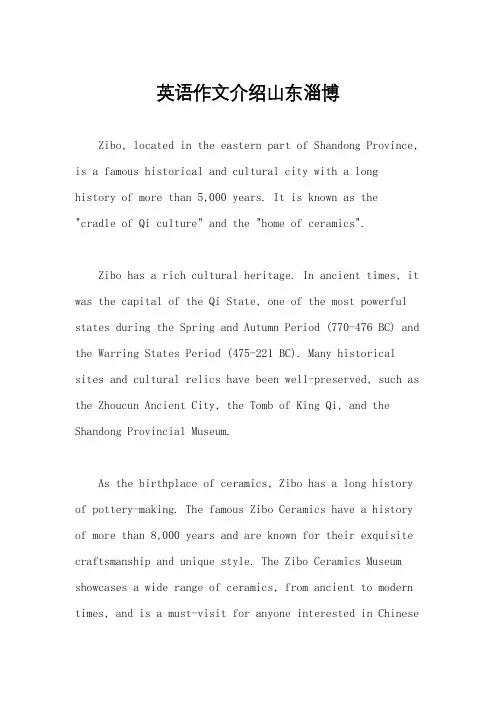
英语作文介绍山东淄博Zibo, located in the eastern part of Shandong Province, is a famous historical and cultural city with a longhistory of more than 5,000 years. It is known as the "cradle of Qi culture" and the "home of ceramics".Zibo has a rich cultural heritage. In ancient times, it was the capital of the Qi State, one of the most powerful states during the Spring and Autumn Period (770-476 BC) and the Warring States Period (475-221 BC). Many historical sites and cultural relics have been well-preserved, such as the Zhoucun Ancient City, the Tomb of King Qi, and the Shandong Provincial Museum.As the birthplace of ceramics, Zibo has a long history of pottery-making. The famous Zibo Ceramics have a history of more than 8,000 years and are known for their exquisite craftsmanship and unique style. The Zibo Ceramics Museum showcases a wide range of ceramics, from ancient to modern times, and is a must-visit for anyone interested in Chineseculture.Zibo is also a modern industrial city with a developed economy. Its pillar industries include petrochemicals, machinery, and ceramics. The Zibo Hi-tech Industrial Development Zone is one of the most important high-tech zones in Shandong Province, attracting many domestic and foreign companies to invest and develop.In addition, Zibo is a beautiful city with picturesque scenery. The Tai'erzhuang Ancient Town, located in the south of Zibo, is a well-preserved ancient water town with a history of more than 2,000 years. It is famous for its unique architectural style and cultural heritage. The Yunmenshan National Forest Park, located in the north of Zibo, is a popular tourist destination with beautiful natural scenery and a variety of recreational activities.In conclusion, Zibo is a city with a rich cultural heritage, a modern economy, and beautiful scenery. It is a great place to visit and explore for anyone interested in Chinese culture and history.。
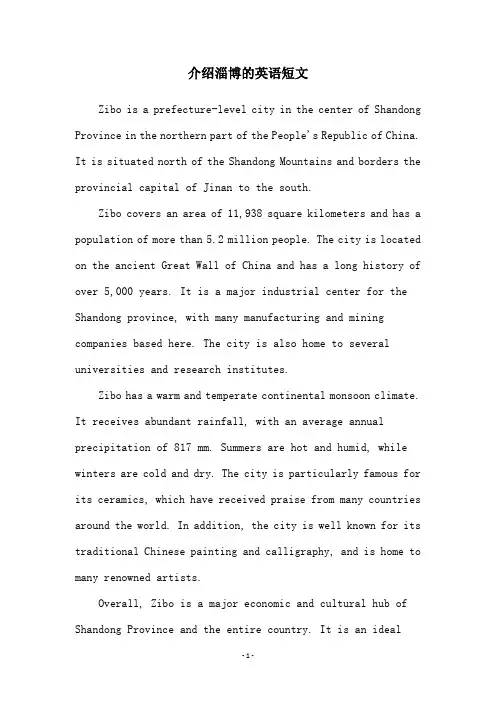
介绍淄博的英语短文Zibo is a prefecture-level city in the center of Shandong Province in the northern part of the People's Republic of China. It is situated north of the Shandong Mountains and borders the provincial capital of Jinan to the south.Zibo covers an area of 11,938 square kilometers and has a population of more than 5.2 million people. The city is located on the ancient Great Wall of China and has a long history of over 5,000 years. It is a major industrial center for the Shandong province, with many manufacturing and mining companies based here. The city is also home to several universities and research institutes.Zibo has a warm and temperate continental monsoon climate. It receives abundant rainfall, with an average annual precipitation of 817 mm. Summers are hot and humid, while winters are cold and dry. The city is particularly famous for its ceramics, which have received praise from many countries around the world. In addition, the city is well known for its traditional Chinese painting and calligraphy, and is home to many renowned artists.Overall, Zibo is a major economic and cultural hub of Shandong Province and the entire country. It is an idealdestination for tourists interested in traditional Chinese culture and history.。
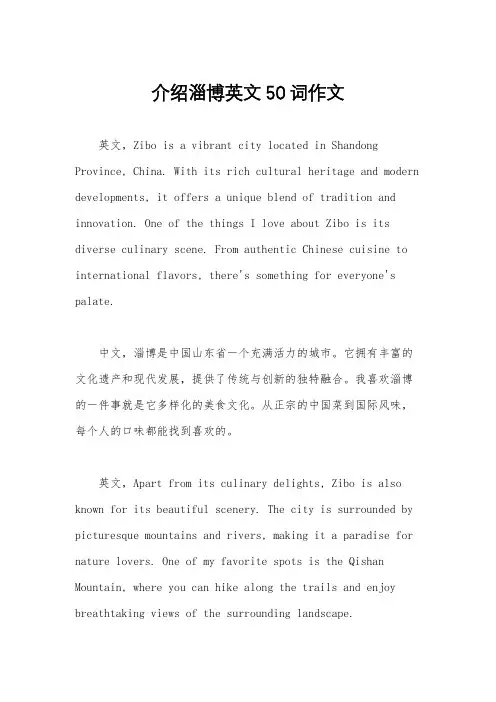
介绍淄博英文50词作文英文,Zibo is a vibrant city located in Shandong Province, China. With its rich cultural heritage and modern developments, it offers a unique blend of tradition and innovation. One of the things I love about Zibo is its diverse culinary scene. From authentic Chinese cuisine to international flavors, there's something for everyone's palate.中文,淄博是中国山东省一个充满活力的城市。
它拥有丰富的文化遗产和现代发展,提供了传统与创新的独特融合。
我喜欢淄博的一件事就是它多样化的美食文化。
从正宗的中国菜到国际风味,每个人的口味都能找到喜欢的。
英文,Apart from its culinary delights, Zibo is also known for its beautiful scenery. The city is surrounded by picturesque mountains and rivers, making it a paradise for nature lovers. One of my favorite spots is the Qishan Mountain, where you can hike along the trails and enjoy breathtaking views of the surrounding landscape.中文,除了美食之外,淄博还以其美丽的风景而闻名。
这座城市周围环绕着如画的山川河流,是自然爱好者的天堂。
my hometown英语作文淄博My Hometown: ZiboZibo, located in the Shandong province of China, is my hometown. With a history of over 2500 years, Zibo is a city rich in culture, tradition, and natural beauty. It is known for its ancient artifacts, traditional ceramics, and stunning landscapes.One of the highlights of Zibo is its famous Linzi District, which was once the capital of the ancient State of Qi. The area is home to numerous historical sites, including the Qi Great Wall, the Zhoucun Ancient Town, and the Linzi Museum. These attractions offer visitors a glimpse into Zibo's long and storied past.In addition to its historical significance, Zibo is also renowned for its traditional ceramics industry. The city has been producing ceramics for centuries, with many skilled artisans continuing this craft to this day. Visitors can explore the various pottery workshops and kilns scattered throughout the city, where they can learn about the complex process of making ceramics and even participate in creating their own pieces.Zibo is also blessed with beautiful natural landscapes. The city is surrounded by lush mountains, serene rivers, andpicturesque lakes. One of the most popular destinations is the Taishan Mountain, a UNESCO World Heritage Site known for its breathtaking scenery and cultural significance. Whether hiking through the mountains or boating on the rivers, visitors can immerse themselves in the peaceful and rejuvenating beauty of Zibo's natural surroundings.Furthermore, Zibo is known for its vibrant food culture. The city is famous for its delicious cuisine, which includes local specialties such as braised pork, steamed dumplings, and hand-pulled noodles. Visitors can feast on these mouthwatering dishes at the city's numerous eateries and street stalls, which offer a taste of authentic Zibo flavors.Apart from its cultural and culinary offerings, Zibo is also a modern and dynamic city. With its expanding economy and rapidly growing infrastructure, the city offers numerous opportunities for business, education, and entertainment. There are bustling shopping districts, vibrant nightlife scenes, and world-class amenities that cater to the needs of both residents and visitors.In conclusion, Zibo is a city that seamlessly blends its rich history with modernity, offering visitors a unique and unforgettable experience. From its ancient relics to its thrivingceramics industry, from its stunning landscapes to its delectable cuisine, Zibo has something for everyone to enjoy. I am proud to call Zibo my hometown, and I encourage anyone seeking a cultural and enriching experience to visit this gem of a city.。
初一英文介绍淄博火炬公园The Torch Park is located in the west of the "Torch Square" in the high-tech zone. It is a lovely place with beautiful scenery all the year round. Spring, the grass quietly from the ground, as if to appreciate the beauty in the park; peach blossom out of the green * small buds, like a shy little girl hide, hiding; all kinds of flowers grow small buds, white, red, purple, blue... colorful, very beautiful! Holly with a head of green hair, with a very straight body, like a flower protection angel general. In the summer, the weather gets hotter and hotter. The sun is like a big ball of fire, the sun is so colorful that the flowers can not lift his head, just like a child did not test well, a very sad appearance. Willow and poplar onion cage, for people to open a green umbrella. Thick layers of branches and leaves cover the sun, the children play games under the tree, the old people get together to play chess, the young people in the kicking, the whole park is full of laughter. Autumn, in the chrysanthemum smile in the flower bed, and the most beautiful is a corridor into the park, purple * grapes hanging on the branches, let a person can not help but want to pick this string of grapes. However, no one goes to pick it, because no one wantsto destroy the beautiful scenery. The autumn wind blowing, I feel myself like dancing in the autumn wind. After the wind, I stopped dancing, in the rest, reading, there is a kind of unspeakable comfortable heart. In winter, the snow falls heavily. After a while, the snow on the ground fell a lot of, willow, poplar branches covered with glittering and translucent shaved snow, and like the white cotton candy, really attractive! And the earth, covered with the sky sent the quilt, deep fell asleep... I love this beautiful torch park!。
初一英语作文介绍山东淄博{z}Title: A Brief Introduction to Zibo, ShandongZibo, located in the southwestern part of Shandong Province, is a prefecture-level city with a long history and rich culture.As a cradle of the ancient Qi culture, Zibo has a history of more than 4,000 years.In this article, I will introduce some of the highlights of this beautiful city.Firstly, let"s talk about the geography of Zibo.The city is surrounded by mountains on the south and east, and bounded by the Yellow River on the west and north.This unique geography has given Zibo a rich variety of natural landscapes, such as mountains, rivers, and lakes.The city is also known for its pleasant climate, with four distinct seasons and a moderate temperature throughout the year.In terms of culture, Zibo has a long and illustrious history.It was one of the important states in ancient China, and many historical figures and celebrities have emerged from this region.The city is also famous for its ceramic industry, especially the Zibo blue and white porcelain, which is renowned for its exquisite craftsmanship and unique aesthetic appeal.Another highlight of Zibo is its cuisine.As a major city in Shandong Province, Zibo offers a variety of delicious dishes.The most famous of these is the Zibo roujiamo, a type of Chinese fast food that is popular throughout the country.Other local specialties include braised pork ribs, pickled vegetables, and various kinds of noodles.Last but not least, Zibo is also a city with a bright future.In recent years, the city has been actively developing its economy, technology, and culture.New industries such as high-tech, biotechnology, and renewable energy have been emerging, and the city has become an important economic and cultural center in Northeast China.In conclusion, Zibo is a city with a rich cultural heritage, beautiful natural landscapes, and a promising future.Whether you are a history buff, a food lover, or just looking for a place to relax and enjoy nature, Zibo has something to offer for everyone.。
介绍淄博英语作文Introduction to Zibo。
Zibo, located in the middle of Shandong Province, is a city with a long history and rich cultural heritage. It is known as the "City of Ceramics" and "City of Qi", and has been an important cultural and economic center in theregion for centuries.Zibo has a history that dates back to the ancient times, and it has been an important center of trade, culture, and industry for thousands of years. The city has been home to many famous figures in Chinese history, including the philosopher and educator Confucius, who was born in the nearby city of Qufu.One of the most famous attractions in Zibo is the Linzi District, which was the capital of the ancient state of Qi during the Spring and Autumn period. The district is hometo many historical sites and relics, including the LinziMuseum, which houses a large collection of artifacts from the Qi state.In addition to its historical and cultural significance, Zibo is also an important industrial center in Shandong Province. The city is known for its production of ceramics, and it is home to many famous ceramic companies and factories. The city's ceramics industry has a history that dates back over 8,000 years, and it is known for producing high-quality porcelain and pottery.Zibo is also known for its beautiful natural scenery, including the picturesque Zibo Lake and the Fushan Mountain. The city's natural beauty, combined with its rich history and culture, makes it a popular destination for tourists from all over the world.In recent years, Zibo has undergone rapid development and modernization, and it is now a thriving city with a strong economy and a vibrant cultural scene. The city is home to many museums, theaters, and art galleries, as well as a wide range of restaurants, shops, and entertainmentvenues.Overall, Zibo is a city with a rich history, a vibrant culture, and a bright future. Whether you are interested in history, culture, or natural beauty, Zibo has something to offer for everyone. It is a city that is definitely worth visiting and exploring.。
用英文介绍淄博作文Zibo, a city located in the Shandong province of China, is known for its rich history and cultural heritage. Thecity has a long history dating back to the ancient times, and it has been a significant cultural and economic centerin the region.The city is home to many historical and cultural sites, such as the Zibo Museum, which showcases the city's history and artifacts from ancient times. The city also has a thriving arts and crafts scene, with many local artisans creating traditional ceramics and other handicrafts.Zibo is also known for its beautiful natural landscapes, including the famous Qishan Mountain. The mountain is a popular destination for hikers and nature lovers, offering stunning views of the surrounding countryside.In addition to its cultural and natural attractions, Zibo is also a modern city with a thriving economy. Thecity is home to many industrial and manufacturing companies, and it is an important center for trade and commerce in the region.Overall, Zibo is a city that offers a unique blend of history, culture, and natural beauty. Whether you are interested in exploring ancient artifacts, enjoying the outdoors, or experiencing modern urban life, Zibo has something to offer for everyone.。
As a Shandong Peninsula economy opening zone city approved by China’s State Council and a “larger city”, Zibo has the local power of legislation. Zibo is also a typical group-style city, with a total area of 5938 square km and a total population of 4.2 million, governs Zhangdian, Zichuan, Boshan, Zhoucun, Linzi 5 districts, Huantai, Yiyuan, Gaoqing 3 counties and Zibo High-tech Industry Development Zone.Cuju, a kind of sports and a way of entertainment, has affected China for more than two thousands year s and had a profound influence on world’s football. On July 15, 2004, FIFA confirmed that China’s ancient Cuju is the origin of football. On September 12, 2005, Linzi Football Museum was unveiled, with an area of 2500 square kilometers. It comprises of the ancient football and the contemporary football, contains 10 exhibiting units. Over 150 pieces of precious cultural relics both in China and overseas throughout the ages, around 300 pieces of historical pictures, and more than 20 restoring scenes displayed systematically show the origin, development, influence, and spread of football for thousands of years.The Ancient Qi City Relics Museum lies in Linzi District, which is famous as the birthplace of world football and a national city of history and culture. The Qi State is one of the countries of the Zhou Emperor (around 1100BC-256BC). When the Tian (a noble family) defeated and replaced Qi, it was called “TianQi”, which is one of the Five Overlords in the Spring and Autumn Period (722BC- 481BC) and the seven rivaling states of the Warring States Period (475BC-221BC). The ancient Qi city is among the first batch of cultural relics protection units authorized by the State Council. With 48 important historical sites inside, it has won the title of the “Underground Museum”. The Qi History Museum is the first, an architecture feature of ancient castle fashion, and is one of the Ten Big Peculiar Museums of China. Three hundred and eight sets or pieces of delicate cultural relics displayed in the 15 exhibition halls show a panorama of the glorious history and culture of Qi state that lasted 800 years. Moreover, the Qi History Museum has won the Top Ten Elite Displaying Nomination Prize.People visit the international ceramic art expo in Zibo, one of the five major ceramic cities in east China's Shandong Province, Sept. 6, 2009. The fair attracted more than 1,500 ceramic enterprises and dealers across the country.(Xinhua/Dong Naide)no matter how tired, how hard, as long as that home, the body have become particularly easy——杜丽博山烩菜Soft Hodgepodge is a traditional local snake in Boshan. Its ingredients include chicken, duck, fish, meat, kelp, cabbage, lotus root, etc. you can choose whatever you like. The tender fish and soft meat features in the dish. Tastes good, oily but not rich, and with a sweet and sour taste, it is available for people of all ages. Now the dish has become a winter delicacy in restaurants, hotels in Zibo.。